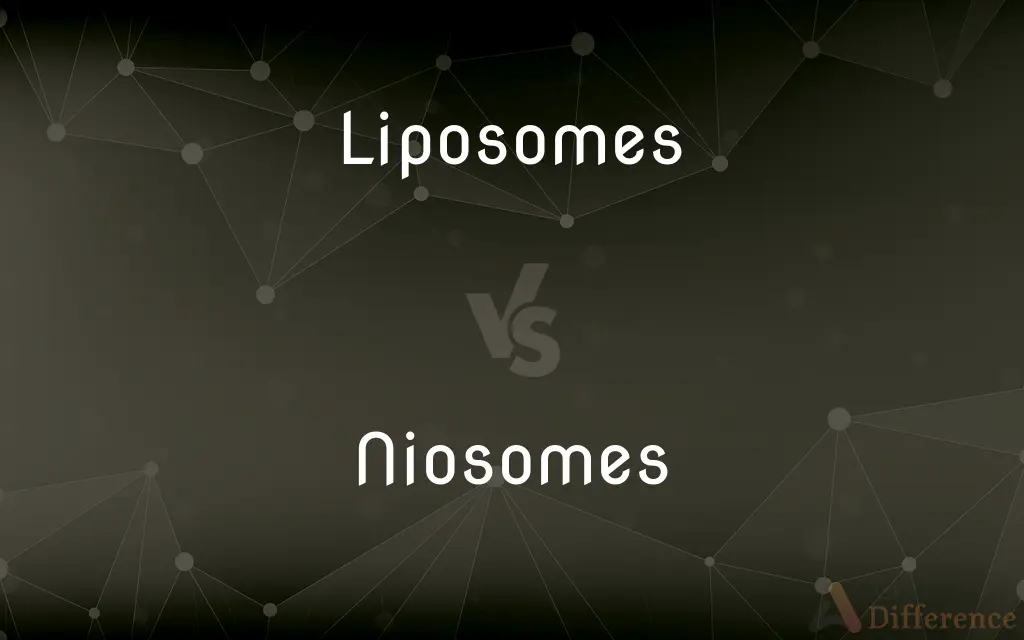Liposomes vs. Niosomes — What's the Difference?
By Tayyaba Rehman — Published on November 28, 2023
Liposomes are vesicles formed from phospholipids, often used in drug delivery; Niosomes are similar vesicles but are made from non-ionic surfactants.

Difference Between Liposomes and Niosomes
Table of Contents
ADVERTISEMENT
Key Differences
Liposomes are small, spherical vesicles which can be produced when aqueous solutions are added to phospholipids. These vesicles are made up of lipid bilayers. Niosomes, on the other hand, are also spherical vesicles but are formed when non-ionic surfactants are hydrated in the presence of cholesterol or other lipids.
Liposomes, due to their composition, have been widely researched for drug delivery systems because they can encapsulate both hydrophilic and lipophilic compounds, offering protection and controlled release. Niosomes serve a similar purpose. Like Liposomes, Niosomes can encapsulate various drugs, enhancing their stability and bioavailability.
In terms of stability, Liposomes can be unstable and may oxidize, which can be a drawback in some applications. Niosomes, since they're derived from synthetic non-ionic surfactants, offer better stability in this regard, being less prone to oxidation. This is one reason why Niosomes have gained interest in pharmaceutical and cosmetic sectors.
It's important to understand that while both Liposomes and Niosomes are vesicles used for drug delivery, their origin and composition differ. Liposomes have a natural origin (phospholipids) and have been studied extensively, while Niosomes, being synthetic, offer certain advantages like better shelf life and stability.
Comparison Chart
Composition
Made from phospholipids.
Made from non-ionic surfactants.
ADVERTISEMENT
Origin
Natural.
Synthetic.
Stability
Can be prone to oxidation.
Generally more stable and less prone to oxidation.
Use
Widely used in drug delivery.
Used in drug delivery, gaining traction in cosmetics.
Physical Appearance
Spherical vesicles with lipid bilayers.
Spherical vesicles formed from surfactant molecules.
Compare with Definitions
Liposomes
Vesicles formed from phospholipids.
Liposomes can encapsulate drugs for targeted delivery.
Niosomes
Vesicles formed from non-ionic surfactants.
Niosomes can enhance the bioavailability of certain drugs.
Liposomes
Spherical structures with a bilayer composition.
The bilayer structure of Liposomes makes them suitable for housing both hydrophilic and lipophilic substances.
Niosomes
Comparable to Liposomes in encapsulating substances.
Niosomes can house various therapeutic agents, similar to Liposomes.
Liposomes
Natural vesicles used for drug delivery.
Liposomes improve drug stability and control their release.
Niosomes
Synthetic vesicles used for drug and cosmetic applications.
Due to their stability, Niosomes are increasingly preferred in skincare formulations.
Liposomes
Can be unstable due to lipid oxidation.
Certain drugs might degrade in Liposomes if not properly stored.
Niosomes
Offer improved stability over Liposomes.
The shelf life of products with Niosomes is often longer due to their resistance to oxidation.
Liposomes
Often used in pharmaceutical and cosmetic applications.
Liposomes in cosmetics enhance the delivery of active ingredients to skin cells.
Niosomes
Derived from hydration of surfactant molecules.
The formation of Niosomes involves the presence of cholesterol or other lipids during hydration.
Liposomes
A microscopic artificial vesicle consisting of an aqueous core enclosed in phospholipid molecules, used to convey vaccines, drugs, or other substances to target tissues.
Niosomes
Plural of niosome
Liposomes
Plural of liposome
Common Curiosities
What are Niosomes?
Niosomes are vesicles made from non-ionic surfactants, serving purposes similar to Liposomes but with synthetic origins.
What are Liposomes?
Liposomes are vesicles formed from phospholipids, often used in drug and cosmetic delivery systems.
How are Niosomes formed?
Niosomes are formed by hydrating non-ionic surfactants, often with cholesterol or other lipids.
Which vesicle type is more popular in cosmetics?
While both are used, Niosomes are gaining traction in cosmetics due to their stability.
Do Liposomes and Niosomes have the same appearance?
Both are spherical vesicles, but their composition differs, with Liposomes having lipid bilayers and Niosomes formed from surfactant molecules.
Are there any limitations to using Liposomes?
Yes, Liposomes can be unstable and may oxidize or merge with other vesicles, affecting their drug delivery potential.
How do Niosomes differ from Liposomes in terms of stability?
Niosomes, being synthetic, are generally more stable than Liposomes and are less prone to oxidation.
Can both Liposomes and Niosomes encapsulate hydrophilic substances?
Yes, both can encapsulate hydrophilic as well as lipophilic compounds.
Can Liposomes oxidize?
Yes, Liposomes can be prone to oxidation, which can affect their stability.
Are Liposomes natural or synthetic?
Liposomes are natural, derived from phospholipids.
Why are Liposomes used in drug delivery?
Liposomes can encapsulate and protect drugs, offering controlled release and improved bioavailability.
Are Niosomes natural like Liposomes?
No, Niosomes are synthetic, derived from non-ionic surfactants.
How do Niosomes enhance drug delivery?
Niosomes can improve drug stability, control release, and increase bioavailability.
Why are non-ionic surfactants used in Niosomes?
Non-ionic surfactants are used because they form vesicles easily, are biocompatible, and enhance drug solubility and stability.
Can Niosomes be used in targeted drug delivery?
Yes, like Liposomes, Niosomes can be engineered for targeted drug delivery to specific cells or tissues.
Share Your Discovery

Previous Comparison
Natural Rubber vs. Synthetic Rubber
Next Comparison
PSD vs. PNGAuthor Spotlight
Written by
Tayyaba RehmanTayyaba Rehman is a distinguished writer, currently serving as a primary contributor to askdifference.com. As a researcher in semantics and etymology, Tayyaba's passion for the complexity of languages and their distinctions has found a perfect home on the platform. Tayyaba delves into the intricacies of language, distinguishing between commonly confused words and phrases, thereby providing clarity for readers worldwide.












































